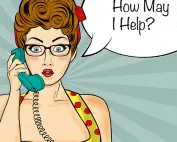How to Handle Difficult Customers
Customers are a company’s greatest asset, and angry customers are their greatest challenge. Providing good customer service is a proven strategy for growing a business, but sometimes you have to let bad customers go.
0 1
Why are some customers difficult?
In the digital age, customers have a wealth of options for goods and services at their fingertips. Demanding customers are more common as a result. This can benefit you because good customer service makes your business stand out. However, stories of bad customer service on social media or customer review sites can go viral.
Dealing with difficult customers requires a cool head, thick skin, and strong communication skills. Not all customer complaints are equal though. Some difficult people will be impossible to please. A savvy business owner understands the difference between a demanding customer and one who should take their business elsewhere.
There are different types of difficult customers: irate customers, vague customers, indecisive customers, verbally abusive customers, impatient customers. Even really talkative customers can be challenging.
Customer service’s first job is to actively listen to verbal and nonverbal cues to understand a customer’s feelings and concerns.
Prefer to listen?
Why customers become difficult and how to with them
A customer had a bad experience::
If you have a business, eventually you’ll be encountering difficult customers disappointed by your product or service. Some unhappy customers merely want to feel they are being heard. Make sure they understand you are taking their concerns seriously. If their complaint is something that needs to be addressed, put processes in place to resolve the situation.
A customer wants someone to be accountable:
At times, a customer will want someone to take responsibility for their poor experience. In this case, make sure you clearly understand the problem. Thank the customer for bringing the matter to your attention. Assume responsibility and inform the customer you will use their feedback to resolve the issue. If they want an explanation, provide an honest answer and thank them again for their feedback.
A customer wants their problem resolved:
A complaint followed by a question of what you’re going to do about it signals a customer seeking reimbursement. First, apologize for the customer’s unsatisfactory experience. Ask for the precise details of their complaint. This lets them know you are taking the customer complaint seriously and you’re building rapport with the upset customer. This also allows you to determine how to move forward
The solution might be as simple as offering a replacement or a refund and an apology. Weigh the costs of such things against the cost of a bad review. Goodwill can grow your business, but don’t let people take advantage of your generosity.
A customer has had a bad day:
A person’s emotional state can directly impact how they perceive their customer experience. A customer might be irate and yell or be rude. This is the time to flex your customer service skills and practice active listening. Remember you don’t know what happened to that person before they walked into your retail establishment, made the phone call, or clicked on your website. They might be unaware they’re being a rude customer.
“Your most unhappy customers are your greatest source of learning.” – Bill Gate
0 2
How to communicate with angry customers
Always begin every customer service communication with sympathy for their unsatisfactory experience and actively listen to their complaint. These are core strategies for dealing with customers. For active listening tips, see our blog Ten Soft Skills You Need.
Being polite and remaining calm with a pleasant voice will help ease their stress. This is especially true for phone etiquette on customer calls because they cannot see your body language. It might be a difficult conversation, but try to determine whether it’s a problem needing a solution or if this is someone who simply enjoys complaining.
Effective customer service begins and ends with effective communication. Improving your communication strategies will help in difficult customer situations and tricky customer conversations. To discover new ways to build up your communication skills, check out our blog Top 10 Soft Skills You Need.
Paraverbal Communication: “It’s not what you say, it’s how you say it.” Paraverbal Communication consists of 3 areas — pitch, tone, and speed of speech. Mastering these will help you handle customers’ emotional reactions.
Non-verbal Communication: For face-to-face encounters, your posture, hand placement, eye contact, and facial expressions will be important means to convey sincerity and a desire to resolve customer complaints. Be aware of the messages your body is sending, such as folded arms when dealing with angry customers.
There are also some fundamentals of customer service training you can put into place. When you have an unhappy or rude customer, let them know they are important by following the STAR methodology:
Situation: Immediately state the situation to the upset customer. What is the issue that needs resolution?
Task: State the task in which this problem occurred. How did it happen?
Action: Clearly explain to your customer your plan of action.
Result: Ensure you update your customer upon resolution. What was the result?
I the customer always right?
“No situation can become favourable until one is able to adapt to it and does not wear oneself out with mistaken resistance.” – I Ching
The customer isn’t always right, but often they are. You must decide how to prioritize your needs against those of your customers. However, never turn your bad day into a bad customer experience.
Every situation is different and will require different customer engagement strategies. Weigh the costs of making a customer happy against those of letting them go.
This is a tough conversation. Ensure you carefully note the customer journey and present it to your boss. Explain why you think it’s time to move on and how you can use the free time to better serve other customers.
0 3
When to say goodbye to bad customers
Customer support and customer service are different. Customer service refers to the type of service customers receive before, during, and after a transaction. Customer support goes beyond the sale, creating an environment of engagement for your customers to keep them happy and retain future business. This is where you find out the real value of a customer.
However, and perhaps surprisingly to hear, not every customer is worth having. Sometimes your product isn’t a good fit for them. Sometimes they are just so demanding they eat your time, resource and profits. It’s okay to let a customer go.
Knowing when to say no or when to allow an unproductive client relationship to end shows a mastery of customer service. If your product or service isn’t a good fit for your customer, you will likely never make them happy. Be honest with these customers and tell them you believe there are other companies better suited to their needs.
This is one of our executive briefings taken from our series of professional online business short courses from ELL. We have over 150 courses online with over 1,000 hours of e-learning covering a wide range of topics across leadership, management and personal & professional development created by industry experts and learning professionals.
Handling Difficult Customers Course
What is the best way to handle a difficult customer? Building rapport? Learning stress management techniques? Recognising body language triggers? With our Handling Difficult Customers course, you will be able to develop a strong skill set including in-person and over the phone technique, being able to address complaints and generate new business.
By the end of these courses, you’ll be able to:
- Have a comprehensive for how diversity adds value to an organisation
- Recognise how to support and work with diverse constituencies
- Break down barriers that come with stereotypes
- Identify areas of concern and how to deal with issues
- Deal practically with cases of discrimination
In each of our business courses, you get access to around six hours of e-learning that you can watch, listen and read. There are usually 100 questions and at the end of the course you will receive a certificate of completion that you can use against any personal or professional development requirements. As well as the course, you also receive a FREE e-book that you can read on your Kindle or other e-reader. You also get a FREE audiobook of the course so you can listen to the whole course uninterrupted on your device.











